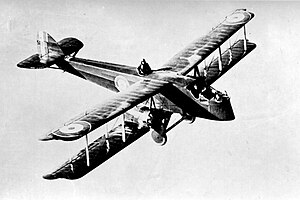
The Hawker Harrier was an experimental biplane torpedo bomber aircraft built by Hawker Aircraft to a specification issued in the 1920s for the RAF.
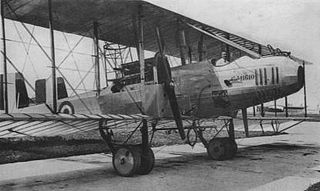
The Caproni Ca.5 was an Italian heavy bomber of the World War I and the postwar era. It was the final version of the series of aircraft that began with the Caproni Ca.1 in 1914.

The Vickers Type 131 Valiant was a British general-purpose biplane produced by Vickers in 1927, with the intention of replacing the Royal Air Force's Airco DH.9As, but was unsuccessful, with only a single example built, which was sold to Chile.

The Airco DH.10 Amiens was a British twin-engined medium bomber designed and built towards the end of the First World War. It served briefly postwar with the RAF.
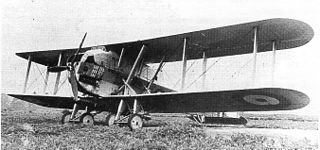
The Blackburn T.4 Cubaroo was a prototype British biplane torpedo bomber of the 1920s. Built by Blackburn Aircraft and intended to carry a large 21 in (533 mm) torpedo, the Cubaroo was one of the largest single-engined aircraft in the world at the time of its first flight.

The Airco DH.3 was a British bomber aircraft of the First World War. The DH.3 was designed in 1916 as a long-range day bomber by Geoffrey de Havilland, chief designer at the Aircraft Manufacturing Company. It was a large biplane with wide-span three-bay wings, slender fuselage, and a curved rudder. It was powered by two 120 hp (89 kW) Beardmore engines, mounted as pushers between the wings. In addition to tailskid landing gear, two wheels were placed beneath the nose to prevent bumping.
The Austin Greyhound was a British two-seat biplane fighter aircraft of World War I built by car manufacturer Austin. Owing to the end of the War and an unreliable engine, it was unsuccessful, only three being built.
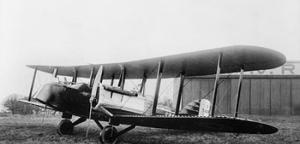
The Avro 533 Manchester was a First World War-era twin-engine biplane photo-reconnaissance and bomber aircraft designed and manufactured by Avro.
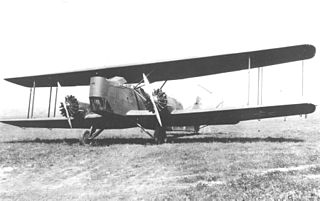
The Keystone XLB-3 was a prototype bomber biplane developed in the United States in the late 1920s. It was a twin-engine development of the single-engine LB-1, brought about by a change in policy by the United States Army Air Corps (USAAC).
The Sopwith B.1 was an experimental British bomber aircraft of the First World War. A single-seat, single-engined biplane, the B.1 was built by the Sopwith Aviation Company for the Royal Navy. Although only two were built, one was used for bombing raids over France.
The Grahame-White Ganymede was a prototype British heavy night bomber intended to serve with the Royal Air Force in the First World War. A large, three-engined, twin-boom biplane, the sole prototype Ganymede did not fly until after the war had ended, and although an attempt was made to convert the aircraft to an airliner, it was unsuccessful.
The Nieuport London was a British night bomber aircraft designed in the First World War. A twin-engined triplane, the London was dogged by the unavailability and unreliability of its engines, and did not fly until 1920. Only two were built.
The Boulton & Paul P.7 Bourges was a prototype British twin-engined biplane day bomber built by Boulton & Paul to replace the Airco DH.10. Despite demonstrating excellent performance and manoeuvrability, only three prototypes were built, post World War I cost cutting leading to the DH.10 not being replaced.

The Westland Weasel was a prototype British two-seat fighter/reconnaissance aircraft of the First World War. Designed to replace the Bristol Fighter, the Weasel was a single engined tractor biplane. Four prototypes were built, but no production followed owing to the failure of its original engine, although the prototypes were used as engine test beds for the successful Armstrong Siddeley Jaguar and Bristol Jupiter engines.

The BAT F.K.25 Basilisk was a prototype British fighter aircraft of the First World War. A single engined biplane intended to meet a requirement to replace the Sopwith Snipe, the Basilisk was unsuccessful, only three being built.

The de Havilland DH.56 Hyena was a prototype British army cooperation aircraft of the 1920s. A single-engined biplane, the Hyena was designed against an RAF requirement, but was unsuccessful with only two being built, the Armstrong Whitworth Atlas being preferred.
The de Havilland DH.72 was a large British three-engined biplane bomber, designed as a Vickers Virginia replacement. It did not go into production.
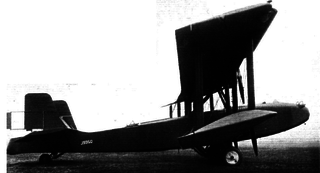
The sole Boulton & Paul P.32 was a British three-engined biplane built to an Air Ministry specification for a long range night bomber. A lack of engine availability slowed construction and by the time it went for tests the thinking on bomber types had moved on.
The Sopwith Cobham was a British twin-engined triplane bomber aircraft designed and built by the Sopwith Aviation Company during the First World War. The only twin-engined aircraft built by Sopwith, the Cobham did not fly until after the end of the war, and was unsuccessful due to the failure of its engines, only three prototypes being built.
The Dyott Bomber was a prototype twin-engined British biplane bomber aircraft of the First World War. Two examples were built but the type was not adopted for service.
